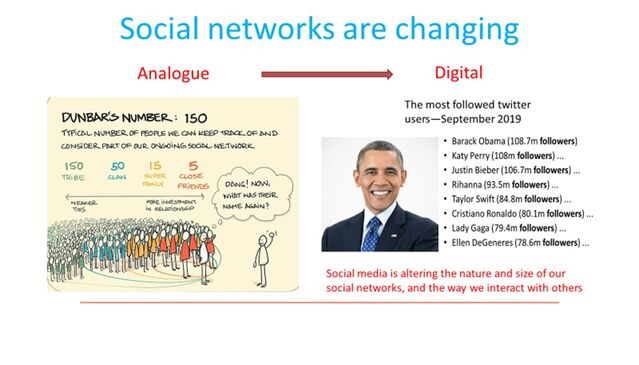Media
The Future of Communication
In the digital age, technology is transforming how and what we communicate.
Posted July 21, 2020 Reviewed by Jessica Schrader
The future is notoriously difficult to predict. For instance, in one scene from the cult classic sci-fi movie Blade Runner, the main character, Deckard, played by Harrison Ford, is in a bar. He makes a phone call to Rachel, with whom he’s falling in love, and invites her to join him for a drink. But while the future Los Angeles involves off-world colonies, cyborgs, or "replicants" as they are termed, and hover cars, Deckard places the call from a hard-wired "Vid" phone on the wall. Apparently, foreseeing the invention of mobile phones was a step too far for the 1982 movie.
Future tech and communication
Predicting the future is even thornier when considering human communication. From the perspective of technological innovation, we are living in a digital age: technology is transforming the ways we communicate with one another, and interact with the world around us. Meanwhile, other technological pipe dreams that were once only the preserve of science fiction are now becoming reality.
For instance, John Anderton, the character played by Tom Cruise in the 2002 movie Minority Report—originally a short story by Philip K. Dick, as was Blade Runner—wears a data glove, providing a sophisticated gesture-based interface system. But touch-based computing is now de rigueur, with the pinch, pull, and swipe features of Apple iPads and iPhones having led the way in the 2000s. In computer gaming, the Wii in 2006, and later, Microsoft Kinect consoles developed similar ways of interacting and controlling virtual characters and actions. Devices such as these are surely but a prelude of what is to come.
MIT computer scientist John Underkoffler predicted, in his 2010 TED talk, that virtual touch-based computing, à la Minority Report, is the future of human-computer interfaces; and at the time of writing, he is leading the development of an immersive human-computer interface environment that aims to fully replicate the science fiction of fully intuitive gesture-based systems.
Perhaps an even more exciting area of research, one that will transform how we communicate with computers over the longer term, is so-called brain-computer interfaces. In the 1995 film Johnny Mnemonic—a cyberpunk action thriller, based on the short story by William Gibson—the protagonist, played by Keanu Reeves, wears a cybernetic brain implant that stores information that can be extracted.
Today’s research on brain-computer interfaces works on a related idea: the brain makes use of electrical signals—an electrical code—to transmit and process information. For instance, sensory information, such as light and sound, harvested by the eyes and ears, is transduced into an electrical nerve impulse that the brain can process. Research on brain-computer interfaces works on the same principle—the idea is that as the brain runs on electrical signals, and assuming these can be accurately read, then the signals should allow us to communicate with external devices via the transmission of electrical impulses directly from the brain. For instance, it should be possible, at least in theory, to harness the brain signals that move your arm and hand to control a robotic arm to, say, pick up a cup of coffee.
Research of this kind is ongoing. It is already becoming possible for amputees to use prosthetic limbs with the aid of computer software; and the aim is to interpret the brain’s electric signals—to control action through thought. In research undertaken by the U.S. government’s Defense Advanced Research Projects Agency (DARPA), subjects who have lost limbs are now able to ‘feel’ sensations, due to electronic communication between ‘bionic’ prosthetics and the brain. This works by using microprocessors in the bionic limb to ‘complete’ the brain’s neural circuit. Outside such specialised research venues, cochlear implants, allowing the hard of hearing to hear, are currently the most widely available use for this technology. The principle enables brain signals to communicate with the implant, thereby overcoming the damaged part of the ear. In the future, it may be possible for implants in the brain to allow us to communicate directly with and control a wide array of devices, using the power of thought alone, as recently advocated by Elon Musk’s Neuralink project, which proposes embedding microchips into the human brain.
In terms of interpersonal communication, some of the earliest predictions about mobile or virtual communication have come true. The hand-held communicators used by Captain Kirk and Mr. Spock in the original 1970s episodes of Star Trek are essentially hands-free mobile devices, with Bluetooth earpieces. That said, contemporary mobile phones do, nevertheless, require earth-orbiting satellites; hence, their communication range does not encompass subspace transmission, and as such, is not intergalactic—just yet.
Computers and smartphones now come with fixed cameras as standard. This means that we can see the person we are talking to, in real time—media apps such as FaceTime and Skype are cases in point. The next step, perhaps, is the so-called telepresence robot. These are mobile units that host a camera and speaker that can be controlled remotely by someone whose voice and image can be projected. And the virtual person can not only see, via their remote camera, but also follow around and otherwise interact with the person with whom they are conversing. The scope for teleconferencing, and ‘remote’ tours of a specific venue, such as visiting a real-estate proposition, a new factory, or a construction site, are obvious. While today’s telepresence robots are not cheap, the cost is likely to come down and the systems will improve as the technology advances.
The Ratchet Effect
The rapidly changing face of communication is underpinned by what has been termed the ratchet effect. The idea is that culture provides a complex network of shared knowledge, systems, behaviours, and practices. This means that by being born into a given culture, shared knowledge is not something we have to learn anew; rather, and paraphrasing the words of Sir Isaac Newton, we stand on the shoulders of previous generations in order to build up and further advance our knowledge base, including technological developments. Each generation takes the developments of the previous one and extends them; and hey presto, in an increasingly short amount of time, this ratchets up the complexity of the technological advances that see the light of day.
To illustrate, let’s take a whistle-stop tour of some of the headline technological developments of the 20th century. The century began with the infancy of airplanes, automobiles, and radio; it ended with space rockets, space stations, computers, mobile phones, and, in 1997, the advent of wireless (Wi-Fi) internet. The 21st century opened with the launch of mobile internet capability, with so-called third-generation or 3G wireless mobile telecommunications. Today, with 4G and beyond, we take the internet-everywhere almost for granted.
Immediacy and reach: The transformational nature of digital modes of communication
It is doubtless true that the digital age has transformed the nature of human communication. Nowhere is this more evident than in terms of the immediacy and reach afforded by digital forms of communication.
In terms of immediacy, social media updates, and instant messaging enable instantaneous communication. Prior to the advent of digital communication technology, communication with those with whom we were not physically co-located required travel, or correspondence via snail mail. A letter to a person in the next town might take a day or two to arrive. But today we can communicate with those on the other side of the world in real time, even without picking up the phone.
And in terms of reach, the immediacy of our communications reaches an unprecedented number of people, determined by our number of friends on Facebook, followers on Twitter, and connections on LinkedIn, to mention only three popular social media platforms.
The notion of reach, is especially striking, as digital technology is transforming the nature of the social networks with whom we can communicate. In analogue communication, a social network can be thought of as having a limit that relates to Dunbar’s Number: around 150. This is a cognitive limit to the number of people with whom one can maintain stable social relationships—proposed by Robin Dunbar, who found a correlation between primate brain size and average social group size.

In contrast, in digital communication, our social network is only constrained, in principle, by the number of people who have access to the internet—around 3.2 billion people and counting. On Twitter, for instance, Barack Obama reaches over 100 million people with each tweet.
New systems of communication: Emoji
In addition to transforming the nature of our communicative reach, the digital age is also providing opportunities and innovations in terms of new forms and systems of communication. And while the underlying principles of communication remain fundamentally the same, how we communicate is and will continue to be impacted as a consequence.
A salient case in point, in the early part of the 21st century has been the emergence of emoji as a global means of communication. In my book, The Emoji Code, I made the following argument. Technology is not changing the cooperative impulse that underpins communication. Nor is it changing the principles that undergird systems of communication. Rather, technology provides new avenues and opportunities; it provides new channels of communication.

But in certain respects, these channels can be impoverished, initially at least, in terms of current systems of communication. Face-to-face spoken interaction is multimodal. It is a fully immersed experience, in which participants communicate using the full panoply of modes, and make use of linguistic, paralinguistic, kinesic, and visual systems of communication. Patterns of eye gaze and prosody convey different aspects of social meaning that fill out the linguistic meaning.
In contrast, abbreviated textspeak is impoverished in the multimodality stakes. And this is where emoji has come into its own; it has begun to allow digital communication to replicate some of the non-verbal communicative cues available to face-to-face interaction. It is not that emoji represents a step-change in communication; rather, and somewhat more prosaically, emoji is providing an inevitable step in plugging a gap in a new channel of communication: the digital.
Without emoji, part of what provides a well-rounded communicative message is missing. And given that textspeak is a visual form of representation, it is inevitable that pictographic representations should help provide some of the paralinguistic and kinesic cues.
Emoji provides a starting point to provide a multimodal system of communication, fit for purpose, in the digital age. We might speculate on how emoji will develop—in the short term, animated, avatar-like emojis might be one way in which textspeak can be further enhanced by multimodal cues. Facial expressions and gestures are what make us who we are: let’s see it, and not be afraid of seeing it, in emoji!
Whatever the next stage in the evolution of emoji and, indeed, other emerging systems of digital communication, the driver is, ultimately, the cooperative intelligence that makes us the unparalleled communicators we are. Emoji makes us more effective communicators in our 21st-century world of communication.




